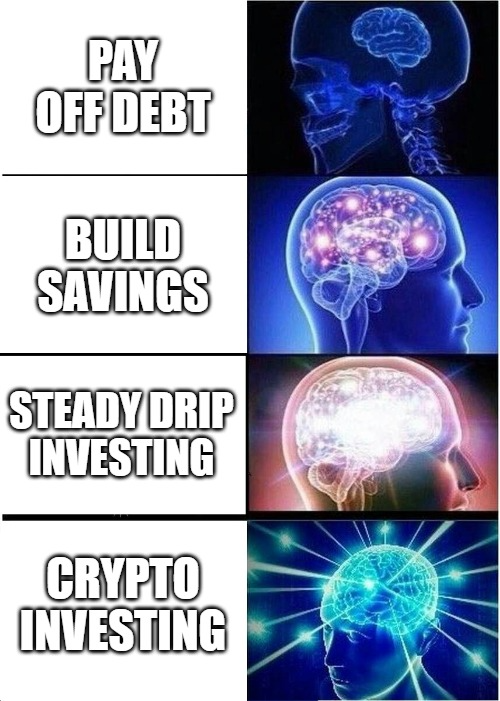
At Bitcoin Market Journal, we have a simple investing philosophy:
- Buy and hold bitcoin;
- Plus a few high-quality digital assets;
- In a balanced portfolio (say, 30% stocks, 30% bonds, and 10% crypto);
- Investing the same amount, at the same time each month;
- Over the long term (5+ years)
This is a radically different approach to crypto than most people take. But increasingly, this is just becoming common sense, because our approach has made a lot of money for our investors:
Another way we’re different: we actually share our results.
In this guide, we’ll explain why our approach works, and how a few core investing principles can make you a world-class crypto investor.
Crypto is a Roller Coaster
When we started Bitcoin Market Journal back in 2017 (making us one of the longest-running crypto investment sites in the world), the first crypto gold rush was underway. People were becoming millionaires overnight. Huge parties. Lambos everywhere.
A few months later, it collapsed. No more parties. Lambos repo’d.
Since then, we’ve seen multiple boom-and-bust cycles in crypto, each bigger than the last. People excitedly buy into crypto when the price is going up, and they sell when it’s going down. They “buy high, sell low,” which is exactly the opposite of successful investing.
Crypto is a roller coaster.
Like wearing a seat belt on a roller coaster, there are a few ways to protect ourselves from making a ton of money in crypto, then losing it all:
Steady-Drip Investing: We invest a little bit of money at the same time each month, through automatic withdrawal from our bank account (see our guide here). We want to “set it and forget it,” which protects us from the emotional buying and selling that drives everyone else.
Diversification: We put just a small slice of our overall investing portfolio into crypto (rule of thumb: 60% in stocks, 30% in bonds, no more than 10% in crypto). This means if bitcoin goes to zero tomorrow, we’ve lost a maximum of 10% of our investments.
Avoid Trading: The crypto world is divided into two sets of people: “investors” and “traders.” We are investors. Every time traders make a trade, they lose a portion of their wealth in taxes and fees. Investors buy and hold quality crypto assets for the long term, 5 or more years.
“Our favorite holding period is forever.” – Warren Buffett
Over the long term, we’ve built a loyal following of what we call “value crypto investors”: following the principles of “value investing” popularized by Warren Buffett and Benjamin Graham, applied to the new world of crypto.
Here’s what that means.

Cryptos are Like Companies
When you buy a share of, say, $AAPL, you become a part owner of the Apple corporation.
When you buy a token of ETH, investors think of it like owning a part of the Ethereum “company.”
Note that technically there is no Ethereum company. (It’s a decentralized network.) You have no legal rights, as you have with Apple stock. Technically, stock shares and crypto tokens are two different things.
But emotionally, they’re the same.
It’s clear that investors think and feel they’re owning part of the Ethereum “company” when they buy ETH. In fact, the entire crypto ecosystem is modeled after the stock market, with charts, metrics, and reports. This is obvious.
While cryptos and companies are legally different, it’s clear that investors think of them the same.
To simplify our thinking, we treat cryptos like companies, and we treat tokens like shares.
There are important differences, but if we start with this assumption, then we can start to value cryptos like companies.
As crypto value investors, we can begin to look for real value. This has two parts.

Quantitative: Evaluating the Numbers
The first part of evaluating crypto companies is by looking at the numbers.
In some ways, cryptos are even better than companies, because you can see all the numbers in real time.
This is one of the great things about blockchain, the technology behind crypto: you can see how a crypto company is doing, because everything is open on blockchain. There’s nowhere to hide.
(Compare this to a traditional company like Apple. Want to know how Apple products are selling? You’ll have to wait for their next earnings report, which comes out months after the fact.)
Just as we look at earnings reports and financial statements of traditional companies, these quantitative metrics are how we evaluate the health of a crypto company. (See our guide to the numbers here.)
But when looking for great crypto investments, numbers are only half the equation.
Qualitative: Evaluating the Business
The second part of finding great crypto companies is by looking at the business.
For this, we’ve developed a free downloadable tool: our industry-leading Blockchain Investor Scorecard.
By answering a few questions about a crypto company, we can start to uncover whether it’s offering a useful product to eager customers, or whether it’s a pipe dream. Very few investors do this kind of research, which gives us an enormous competitive advantage.
Better yet, our scorecard lets us compare different companies against each other, using a simple 1- to 5-star rating system. (See our guide to the scorecard here.)
You’re welcome to do the research yourself, or you can become a Premium Member and get access to our library of Investor Scorecards for all the top crypto assets, created by our team of professional analysts. (Click here to join.)
Crypto is Really Interesting and Fun
Many of us invest because we’ve fallen in love with this industry. We understand it has world-changing potential.
The very nature of money is changing, making crypto one of the greatest technological revolutions in human history.
Ultimately, we believe that crypto will lead to a one-world money, which will be a massive improvement on the way we do things today, more fair and equitable to all:
See my TED talk: “One World, One Money”
These revolutions play out over decades, so if you’re just joining us, you’re not too late. We’re only getting started.
Welcome to the crypto revolution.
Health, wealth, and happiness,
John Hargrave
Publisher, Bitcoin Market Journal

